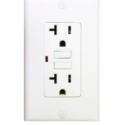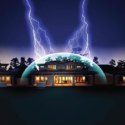
Lights That Flicker May Be The Sign Of Several Different Problems
You flip a switch, and the room’s light bulbs lazily blink to life. At that moment, your mind fills with hundreds of questions. Was the light always like that? Do you need to change a bulb? Is your home about to burn down?
A light bulb burning out is a minor annoyance, but a light that flickers? That can be an entirely different beast. The problem may lie in the light bulb itself or result from a much larger issue just waiting to ruin your day. Even if you’ve come to enjoy the steady pulse and buzz of electricity throughout your home, it might be safer to look for the source of your problem.
Why Do Lights Flicker?
The source of a light flicker could be as simple as a loose light bulb or as complex as a circuit near its load capacity. When the light begins to flicker, your first course of action should be to check the bulb itself. The solution may be as easy as re-tightening the bulb’s connection to touch the socket tab. If the bulb seems scorched from the inside out, the filament is close to burning out, and you should replace the bulb.
If the flickering persists after changing a lightbulb, you may want to direct your attention toward the connected light switch. Upon inspection, the toggle is warm to the touch, producing soot or emitting a sulfurous odor. These are signs that the connection is faulty at this junction. Light switches can prevent the proper flow of electricity from reaching your light bulb when installed incorrectly.
If neither of these seems to be the source of your light’s flicker, then the problem is far beyond the scope of a single lightbulb. Although you could try to locate the problem yourself, you’re far better off having a professional do it.
What Makes A Light Switch Fail?
When you flip the lever on a wall switch, you expect a nice *snap* before the lights come on. This sound means a spring-loaded gate changes a position to open or close an electrical connection. Switches missing this audible feedback often have worn springs that no longer properly open or close their gates (unless they’re “quiet switches”). Even if the switch mechanism works well, faulty connections on the switch itself may be reducing the flow of electricity to your light bulb.
The electrical connection at a light switch can become unstable due to age, wear, or improper installation. Faulty connections reduce the amount of electricity that reaches the desired location. Still, they can also be a deadly fire hazard! Suppose you suspect one of your wall switches is faulty. In that case, you should have a professional electrician replace it instead of doing it yourself. Trained electricians can help you determine if replacing a switch will solve your issue or if further; extensive work is needed before your electrical system works correctly.
Whole-Home Problems
After consulting the help of a professional, you may realize that your lights don’t flicker because of a faulty switch or bulb. Instead, your home’s wiring may be outdated or incapable of handling its current load. Most homes run 15-amp circuits that can take a load of up to 1,800 watts. When your appliances and light fixtures begin to reach a circuit’s limit, you’re more likely to experience outages and service interruptions. A flickering light is just one of the many issues arising from a home circuit being pushed to its limit.
If your home was first wired in the 60s and 70s, you might be running into another problem; aluminum wiring. This kind of wiring is less effective than modern and is highly prone to arcing. For example, if your wall switches were warm, it was probably the result of electricity arcing between two wires or contacts behind the switch. This electricity transfer generally happens whenever the current’s flow outpaces a wire’s conductivity. The result is usually harmless but can burn the wire’s insulation and even start a fire. As aluminum wiring is especially prone to wear, arcing is common in homes with this kind of wiring.
How To Handle Larger Problems
The solutions to overloaded circuits and outdated wiring are simple but labor-intensive. To lessen the load of your home’s current course, you can install dedicated circuits for major appliances that draw much power from the rest of your home. You could also install a separate general-use circuit to lessen your home’s overall load.
On the other hand, houses with aluminum wiring will have to be rewired entirely to prevent future problems. During this process, an electrician, or team of electricians, completely replace your home’s existing wiring with a modern option that works best for your home, usually copper. Technicians will also rewire and, if needed, replace all connections, switches, and outlets. While it is an extreme option, whole home rewiring is an excellent way to ensure its wiring is in top condition.
A Flickering Light Is Just A Nuisance Until it’s Not.
In most cases, a flickering light is a problem you can quickly solve yourself. However, a flickering light may accompany a series of other issues in your home. Flipped breakers, outages, electrical shocks, and fires can all follow once your lights exhibit problems. Don’t wait until circuits fail to do something about your situation. Have professionals inspect your home and alert you to any dangers lurking in your home. Call USA Electric today at (818) 705-0893 to speak with an expert who can help you with your problems.
We offer lighting services in the following locations:
- • Culver City electricians
- • West Hollywood electricians
- • Granada Hills electricians
- • Chatsworth electricians
- • Pasadena electricians
- • Burbank electricians
- • Beverly Hills electricians
- • West Hills electricians
- • Tarzana electricians
- • Hollywood Hills electricians
- • Woodland Hills electricians
- • Downtown LA electricians
- • Sherman Oaks electricians
- • North Hills electricians
- • Marina Del Mar electricians
- • Mar Vista electricians
- • Santa Monica electricians
- • West Los Angeles electricians
Leave our Los Angeles electricians a review or learn more about our services at our following business locations:
- West Hollywood electricians
- Tarzana electricians
- Woodland Hills electricians
- Los Angeles electricians
And, if you’re looking for help with your lighting in the Colorado area, then check out our friends over at Lion Home Service! They’d be more than happy to help you out!






